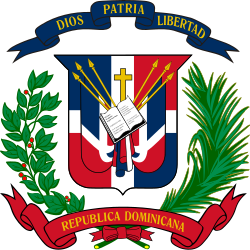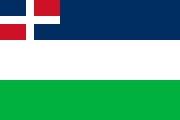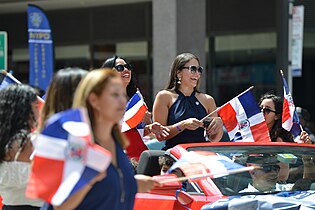
A national flag is a flag that represents and symbolizes a given nation. It is flown by the government of that nation, but can also be flown by its citizens. A national flag is typically designed with specific meanings for its colours and symbols, which may also be used separately from the flag as a symbol of the nation. The design of a national flag is sometimes altered after the occurrence of important historical events. The burning or destruction of a national flag is a greatly symbolic act.

The national flag of Romania is a tricolour. The Constitution of Romania states that "The flag of Romania is tricolour; the colours are arranged vertically in the following order from the flagpole: blue, yellow, red". The flag has a width-length ratio of 2:3; the proportions, shades of colour as well as the flag protocol were established by law in 1994, and extended in 2001. Its similarity to the flag of Chad has caused international discussion.

The national flag of Slovenia features three equal horizontal bands of white (top), blue, and red, with the coat of arms of Slovenia located in the upper hoist side of the flag centred in the white and blue bands. The coat of arms is a shield with the image of Mount Triglav, Slovenia's highest peak, in white against a blue background at the centre; beneath it are two wavy blue lines representing the Adriatic Sea and local rivers, and above it are three six-pointed golden stars arranged in an inverted triangle which are taken from the coat of arms of the Counts of Celje, the great Slovene dynastic house of the late 14th and early 15th centuries.

The national flag of Poland consists of two horizontal stripes of equal width, the upper one white and the lower one red. The two colours are defined in the Polish constitution as the national colours. A variant of the flag with the national coat of arms in the middle of the white fess is legally reserved for official use abroad and at sea. A similar flag with the addition of a white eagle is used as the naval ensign of Poland.

The national flag of Greece, popularly referred to as the "turquoise and white one" or the "azure and white", is officially recognised by Greece as one of its national symbols and has 5 equal horizontal stripes of blue alternating with white. There is a blue canton in the upper hoist-side corner bearing a white cross; the cross symbolises Eastern Orthodox Christianity. The blazon of the flag is Azure, four bars Argent; on a canton of the field a Greek cross throughout of the second. The official flag ratio is 2:3. The shade of blue used in the flag has varied throughout its history, from light blue to dark blue, the latter being increasingly used since the late 1960s. It was officially adopted by the First National Assembly at Epidaurus on 13 January 1822.

The flag of Bulgaria is a tricolour consisting of three equal-sized horizontal bands of white, green, and red. The flag was first adopted after the 1877–1878 Russo-Turkish War, when Bulgaria gained de facto independence. The national flag at times was charged with the state emblem, especially during the communist era. The current flag was re-established with the 1991 Constitution of Bulgaria and was confirmed in a 1998 law.

The flag of Portugal is the national flag of the Portuguese Republic. It is a rectangular bicolour with a field divided into green on the hoist, and red on the fly. The lesser version of the national coat of arms of Portugal is centered over the colour boundary at equal distance from the upper and lower edges. Its presentation was done on 1 December 1910, after the downfall of the constitutional monarchy on 5 October 1910. However, it was only on 30 June 1911, that the official decree approving this flag as the official flag was published. This new national flag for the First Portuguese Republic, was selected by a special commission whose members included Columbano Bordalo Pinheiro, João Chagas and Abel Botelho. The conjugation of the new field color, especially the use of green, was not traditional in the Portuguese national flag's composition and represented a radical republican-inspired change that broke the bond with the former monarchical flag. Since a failed republican insurrection on 31 January 1891, red and green had been established as the colours of the Portuguese Republican Party and its associated movements, whose political prominence kept growing until it reached a culmination period following the Republican revolution of 5 October 1910. In the ensuing decades, these colours were popularly propagandised as representing the hope of the nation (green) and the blood of those who died defending it (red), to endow them with a more patriotic and dignified, therefore less political, sentiment.

The national flag of Fiji was adopted on 10 October 1970. The state arms have been slightly modified but the flag has remained the same as during Fiji's colonial period. It is a defaced cyan "Blue Ensign", with the shield from the national coat of arms. It has remained unchanged since Fiji was declared a republic in 1987, despite calls from some politicians for changes.

The flag of Peru was adopted by the government of Peru in 1825, and modified in 1950. According to the article 49 of the Constitution of Peru, it is a vertical triband with red outer bands and a single white middle band. Depending on its use, it may be defaced with different emblems, and has different names. Flag day in Peru is celebrated on 7 June, the anniversary of the Battle of Arica.

The national flag of Spain, as it is defined in the Constitution of 1978, consists of three horizontal stripes: red, yellow and red, the yellow stripe being twice the height of each red stripe. Traditionally, the middle stripe was defined by the more archaic term of gualda, and hence the popular name la Rojigualda (red-weld).

The coat of arms of Chile dates from 1834 and was designed by the English artist Charles Wood Taylor (1792–1856). It is made up by a figurative background divided in two equal parts: the top one is blue and the bottom, red. A five pointed white star is in the centre of the shield. This background is supported in one side by a condor, the most significant bird of prey from the Andes, and in the other, by a huemul, a mammal endemic to Chile. Both animals wear golden naval crowns symbolising the heroic deeds of the Chilean Navy in the Pacific Ocean.

The Commonwealth of Massachusetts has been represented by official but limited-purpose flags since 1676, though until 1908 it had no state flag per se to represent its government. A variant of the white flag with blue seal was carried by each of the Massachusetts volunteer regiments during the American Civil War alongside the National Colors. An exception were the two "Irish regiments", each of which was permitted to carry an alternative green flag with a harp symbol.

The flag of West Virginia is the official flag of the U.S. State of West Virginia and was officially adopted by the West Virginia Legislature on March 7, 1929. The present flag consists of a pure white field bordered by a blue stripe with the coat of arms of West Virginia in the center, wreathed by Rhododendron maximum and topped by an unfurled red ribbon reading, "State of West Virginia." It is the only state flag to bear crossing rifles, meant to illustrate the importance of the state's fight for liberty during the Civil War as the southern unionist 35th state.

In military organizations, the practice of carrying colours, standards, flags, or guidons, both to act as a rallying point for troops and to mark the location of the commander, is thought to have originated in Ancient Egypt some 5,000 years ago. The Roman Empire also made battle standards reading SPQR a part of their vast armies. It was formalized in the armies of Europe in the High Middle Ages, with standards being emblazoned with the commander's coat of arms.
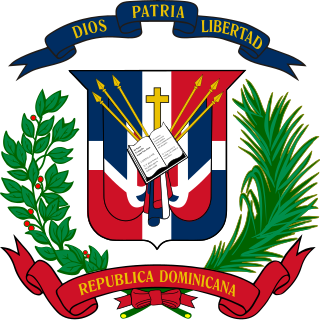
The coat of arms of the Dominican Republic features a shield in similarly quartered colors as the flag, supported by a bay laurel branch (left) and a palm frond (right); above the shield, a blue ribbon displays the national motto: Dios, Patria, Libertad. Below the shield, the words República Dominicana appear on a red ribbon. In the center of the shield, flanked by six spears, the front four holding the national flag, is a Bible which is open to John: 8:31–32 with a small golden cross above it. The coat of arms appears in the center of the flag of the Dominican Republic.
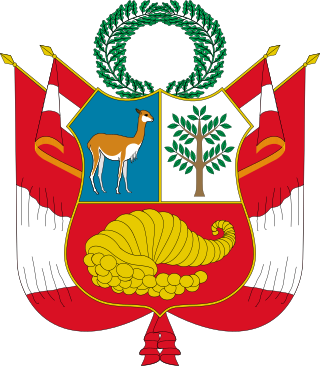
The Coat of arms of Peru is the national symbolic emblem of Peru. Four variants are used: the Coat of arms per se ; the National Coat of arms, or National Shield ; the Great Seal of the State ; and the Naval Coat of arms.
The island nation of Malta has a variety of national flags and symbols, some current and some no longer in use.

The Star of India refers to a group of flags used during the period of the British Raj in the Indian subcontinent. India had a range of flags for different purposes during its existence. The Princely states had their own flags which were to be flown alongside the British flag as a symbol of suzerainty. The official state flag for use on land was the Union Flag of the United Kingdom and it was this flag that was lowered on Independence Day in 1947. The flag of the governor-general of India was defaced with the Star of India. The civil ensign and naval ensign were the Red Ensign or Blue Ensign, respectively, defaced with the Star of India emblem.

The colors of the national flag of Romania has a long history, though the association of the three colors only dates to the 18th century. Red, yellow and blue were found on late 16th-century royal grants of Michael the Brave, as well as shields and banners. Thus, the late 13th century Wijnbergen armorial shows the coat of arms of the Wallachian ruler Litovoi as consisting of a shield of ten vertically alternating gold-and-red bands,. The same two colors, gules and or, also appeared on the late 15th century flag and coat of arms of Moldavia, during the reign of Stephen the Great. Then, from the late 16th century until the mid-17th century, the historical coat of arms of Transylvania gradually developed as a shield party per fess, consisting of a black eagle on blue background in the upper field, a dividing red band in the middle, and seven red towers on golden background in the lower field. Finally, in the last quarter of the 18th century, Bukovina gets its own coat of arms from the Habsburg Empire, a blue-and-red shield party per pale with a black aurochs' head in the middle, and three golden six-pointed stars surrounding it. During the Wallachian uprising of 1821, these three colors were present, along others, on the canvas of the revolutionaries' flag and its fringes; for the first time a meaning was attributed to them: "Liberty (blue-sky), Justice, Fraternity ( blood)".

The flag of Piedmont is one of the official symbols of the region of Piedmont in Italy. The current flag was adopted on 24 November 1995.



